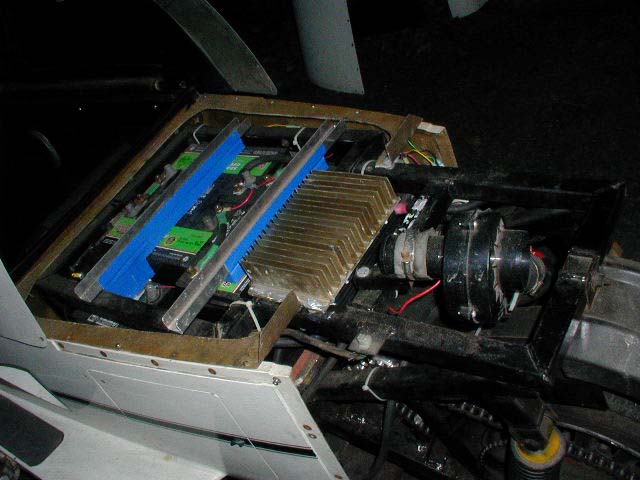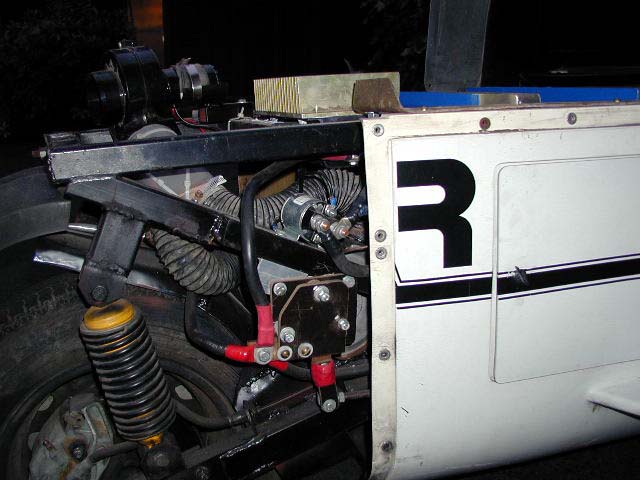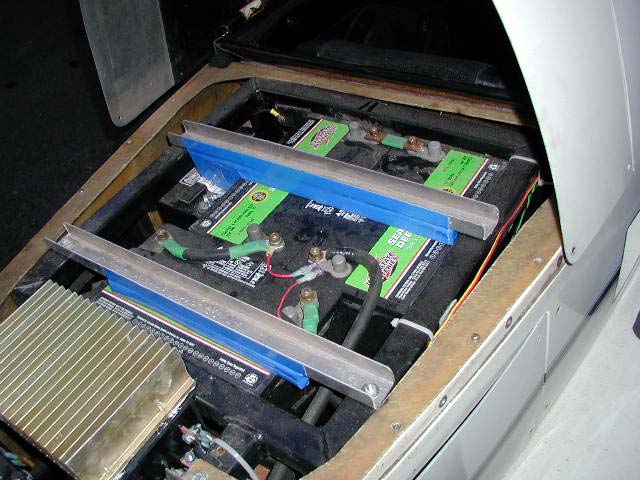Owosso Litestar #009












Dave McCoy of Seattle owns #009 which was built in 1985. He purchased it from Henry Copolla, who was a Litestar dealer and an officer in Tomorrow Corp.
It is also listed as Invoice number 28, Tomorrow Corporation title dated March 11, 1985.
Full VIN is 1LSECP2E1F2000009.
The early Scranton, Iowa and Owosso, Michigan built Litestars had problems with the VIN's and did not have federal safety stickers which supposedly all vehicles manufactured at the time were supposed to have.
Dave converted it to an electric vehicle in about 1990. It uses 6 Interstate lead acid batteries each with 88 amp hours. Each battery is almost 70 lbs. The batteries are in series and the overall system operates at 72 volts. I don't know the brand name on the motor. It was originally used to pressurize hydraulic systems.
The motor is about 7 inches in diameter. Runs on 72 volts and uses about 450 amps at this voltage when I floor it.
I am considering switching to 6 Excide Optima batteries which have a lower amp-hour rating (55-60) but are almost half the weight.
The performance is fine and I love the simplicity of the system overall, but the weight is a real problem. I am going to be investigating my alternatives and either switch batteries or go back to gas.
I don't know what the horsepower is, but I can burn rubber easily and even with the added weight the system will go faster than I have been willing to drive it on local roads. Generates so much torque on the low end that I don't use a transmission.
The size of the full system with motor and batteries is quite small. The batteries and motor combined occupy the space formerly occupied by the motorcycle engine. Obviously I don't need a gas tank and all the space above the engine frame area is now empty so essentially the cargo shelf behind the rear seat could go all the way to the back of the vehicle if one chose. Plenty of room for a generator. I have contemplated installing a generator to extend range, but not sure if this would work out and not many sources for information for this application of portable generators so I have never taken any steps in this direction.
Dave said "1 Gear forward. It does have reverse. The old gear shifting linkage was recruited to provide a mechanical polarity reverse. Works great!"
Dave added, "The whole thing fits comfortably within the body shell with tons of space to spare and I do intend to run with all shell components installed. Basically everything fits below the level of the rear shelf. After I get everything roadworthy, I may use the spare space for a little gasoline engine to generate power for extended range. Depends on what kind of ranges I get with batteries alone.Dave Cloud indicated that low drag should help significantly with range at high speed, but since he doesn't exactly have stats on electric Litestars, he's not sure what the range will be. Performance comes at the expense of range, but I don't know what it's going to be since so far it's only been driven to the brake shop.
This is probably a short-range vehicle only. Given my plans to only run it around the Seattle area, this should be fine."
There are 6 cells at 70 lbs a piece. All 6 are wired in series, so the system is 72 volts. It's electrically isolated from the chassis. There is no energy recovery on braking. This typically doesn't get you much more that 8-10% of the energy back and is electrically cumbersome. Motor weighs 50 lbs. It was a hydraulic pump motor in a previous life. So a 470 lb drive system.
"At that weight, you'd think it would be sluggish, McCoy said, it's pretty zippy. The conversion was done by Dave Cloud who runs Cloud Electric. They do conversions on conventional cars as their main business. Cloud also races electric cars, boats, and motorcycles and holds numerous track records in the area. I told him I only would do the conversion if I could maintain zippy performance. He certainly provided for that. The thing hauls. Most disconcerting thing is when you stop at a light. No sound."
I asked Dave if there was a heating problem. He said: "There is an auxiliary fan for cooling. There are no enhanced scoops since heating is minor. My concern about heat was one of the reasons I went electric. The heat radiator is visible in a couple of the shots." You can see the cage fan on top and the large heat sink just behind it.
Your Host, Steve Schmidt

Last Update: 11-20-23......
This is a personal
website and is not affiliated with the designer, manufacturer or any company officials/employees.
Disclaimer:
Litestar Pulse Website is provided to you free of charge, "as is."
The best efforts to maintain accurate Litestar Pulse
Website history, information, repair tips and content, however, it is
not responsible for the content of its information, opinion providers.
You should not assume that Litestar Pulse Website is error-free and
makes no guaranties as to the accuracy, currency, content, or quality
of any such information.
Copyright 2024 © All rights reserved